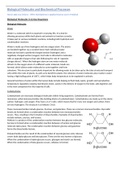Biological Molecules and Biochemical Processes
Stevie-Jade Lisa Vickers – BTEC Nat Diploma in Applied Science Level 3 Medical
Biological Molecules in Living Organisms
Biological Molecules
Water
Water is a molecule which is required in everyday life. It is vital for
allowing processes within both plants and animals to function correctly.
It takes part in various metabolic reactions, including both hydrolysis and
condensation reactions.
Water is made up of two hydrogens and one oxygen atom. The atoms
are bonded together via a covalent bond. Each individual water
molecule has both a positively charged section (hydrogen) and a
negatively charged section (oxygen). Each side is attracted to molecules
with an opposite charge to that side (following the rule of ‘opposite
charges attract’. When the hydrogen atom on one water molecule
attracts to the oxygen atom of a different water molecule, bonds are
formed, which allows water molecules to come together and form
cohesions. This structure is particularly important for allowing water to be taken up by the tube structured transport
cells within the roots of plants. As well as its benefit to plants, the cohesion of water molecules also results in water
having a high boiling point of 100ºC, which helps body temperature to be regulated in animals.
General functions of water within the human body include helping to flush body waste, growth and reproduction,
temperature regulation, keeping membranes moist, assists in the delivery of oxygen to the body, aids digestion and
is the main component for the majority of cells.
Carbohydrates
Carbohydrates are necessary biological molecules within living organisms. Carbohydrates are formed from
monomers called monosaccharides (the building blocks of carbohydrates). Carbohydrates are made up of the atoms
carbon, hydrogen, and oxygen. They have a 1:2:1 ratio, which means that for every one oxygen and carbon, there
are two hydrogens. The structure is as follows: CH 2O.
These monosaccharides include glucose, fructose, and galactose. These are common monosaccharides. Glycosidic
bonds are formed when a condensation reaction between two monosaccharides
occurs. Thus, resulting in the formation of disaccharides. Examples of disaccharides
include maltose, sucrose, and lactose.
Maltose is a product of the condensation reaction between two glucose molecules.
Sucrose is formed when a condensation reaction between a fructose and glucose
molecule takes place. The condensation reaction between glucose and galactose
forms the disaccharide lactose.
Polysaccharides are the result of the condensation of several glucose units. Glucose
covers both alpha-glucose and beta-glucose. These are the two isomers of glucose.
When the condensation of alpha-glucose occurs, glycogen and starch are formed.
When the condensation of beta-glucose occurs, cellulose is formed.
, Glycogen is necessary for animals as it is the ‘stored’ form of
glucose. It acts as a reservoir of glucose for when the animal
body requires an influx of glucose due to a lack of glucose
from food. Glycogen is broken down and used as a quick
release of glucose into the bloodstream and is used as fuel
for the cells in the body.
Starch is the polysaccharide used by the body to make
glucose after digestion. Glucose is an essential molecule to
the body as it is an essential energy source for the cells in the
body. In plants, starch is formed using excess glucose
produced via photosynthesis. This occurs in the leaves. Much
like glycogen acts as an energy reservoir for animals, starch
acts the same way in plants, as a food reservoir.
Also essential to plants is cellulose. Cellulose is required by
plants to maintain their structure. Cellulose is tough and water-insoluble, meaning it keeps the cell walls within
plants stable and contributes to the maintenance of the structure of plants overall.
Proteins
Proteins are the largest unit of cell and are formed from chains of
amino acids. Amino acids are the monomers which are the building
blocks for proteins. There are a total of twenty amino acids. When
condensation reactions occur between more than two amino acids,
polypeptides are formed. These polypeptides are various sequences of
those twenty amino acids that code for different proteins. These
different proteins have different functions within the body, and each
serve different purposes for maintaining proper function of the
human body. Generally, all cell functions require proteins in some
way, and the function of proteins can range from cellular support to
Amino Acid Structure
digestion.
When a condensation reaction between only two amino acids occurs, a dipeptide is formed. When the condensation
reaction occurs between more than two amino acids, polypeptides are formed. Polypeptides code for different
proteins. A protein may consist of either one or more polypeptides.




